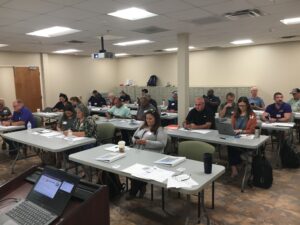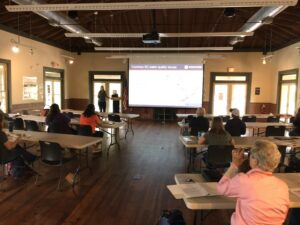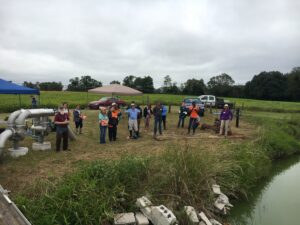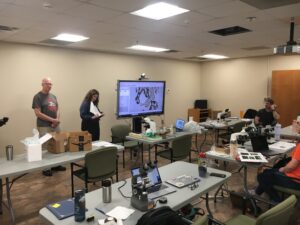Final report for SPDP21-01
Project Information
Agribusiness is the #1 industry in South Carolina (SC), generating approximately $45B annually. Livestock production is one of the top agricultural commodities in SC, and adequate clean water is essential for success. Livestock typically drink from ponds, which can be unreliable during droughts or when impaired by aquatic weeds, especially harmful algal blooms (HABs). Many small livestock operations have only one water source. Risks to livestock health are magnified by climate change, decreasing summer rainfall, and increasing nighttime temperature in SC, which collectively increase the growth of HABs capable of producing off-putting tastes or toxins lethal to livestock, pets, and humans.
Reports of HABs typically started in August; more recently, SC producers began experiencing HABs in June, increasing the duration of livestock exposure to toxins. Producers rely on Agents for advice on many issues. Currently, no clear guidance is available to educate Agents on how to best assist producers in preventing, preparing for, or managing HABs. Alternate water supplies are typically available but may require advanced planning, infrastructure development, or a combination thereof. Improving the information available to prevent and manage HABs would enhance the social, environmental, and economic sustainability of water supplies for livestock production. This multi-institution (including 1862 and 1890 land grant institutions) and multi-discipline project will develop essential materials iteratively incorporating survey results, and host effective participatory training events in collaboration with farmers to enable agents, NGOs and other agricultural professionals to work proactively with producers to implement cost-effective HAB prevention, management, and response options.
Livestock ponds with HABs are of concern for the health of the livestock, as livestock drinking from HAB impacted ponds may lead to poor animal health or death. Various factors such as farm management, water source, rainfall-runoff management processes, and livestock operation type could influence the prevalence and severity of HABs in the ponds. Training and education resources to assist Trainers (Cooperative Extension Agents, NRCS staff, agricultural advisors, and relevant nonprofit advisors) expand knowledge and skills will help better educate farmers, enabling informed decisions related to management of sensitive natural resources, improved livestock health, and increased sustainability of operations and profits. Ultimately, changes in practice by livestock and agricultural producers could minimize the threat of HABs and improve sustainability of livestock operations.
The project goal is to collaborate with farming partners and professionals to develop materials and conduct practical participatory training detailing cost-effective HAB prevention and management options to encourage minimization of risk and to enable fast, effective response for livestock producers dealing with HABs. The training program will lead to increased adoption of farming practices that minimize risks to livestock from HABs, and increase profitability, Extension Agents, NRCS staff, agricultural advisors, and nonprofit advisors are the target audience (“Trainers”). Curriculum and training will build upon and be integrated with the SC SARE program.
We will accomplish the goal by completing six objectives.
- Conducting a facilitated focus group discussion with livestock professionals and mentor farmers to determine barriers to change in practice that limit grower adoption of practices that enhance livestock health while mitigating potential for HABs and to understand the potential areas that the agents are not familiar with on HABs.
- Developing and publishing (digital and print) comprehensive reference materials for Trainers about avoiding/managing HABs in livestock ponds. Materials will include information, pictures, actionable recommendations, and other resources. Developed materials will be available to other trainers throughout the Southeast and US, potentially expanding the outcomes and benefits of this project far beyond SC.
- Providing effective in-person and web-based training (pandemic and non-pandemic situations) about avoiding, managing, and mitigating HABs.
- Establishing a team of expert Trainers ready to educate and assist farmers in implementing practices to prepare for, prevent, or respond to HABs.
- Demonstrating implementation of efficient, cost-effective HAB avoidance and/or management strategies on-farm at mentor livestock producer sites to encourage the adoption of sustainable water management practices throughout SC and the Southeast, and to obtain on-farm experiential learning.
- Evaluating the impact of the trainings and field demonstrations on agents’ knowledge.
The training components, both in-person and web-based, will be developed and administered by an interdisciplinary team with expertise in water quality, HABs, livestock operations, rainfall-runoff processes, weather patterns, nutrient and sediment management, vegetation management, and performance analysis. Various objectives will be accomplished in different phases during the training (see project timeline). Throughout the project, outputs, outcomes, and participant gains in knowledge will be quantified using pre-and post-training surveys. Training effectiveness and constructive means of enhancing training to promote better acceptance/ transfer of knowledge will be evaluated after each training (classroom or field-based training) and subsequent trainings modified to improve delivery of materials.
Behavioral changes pertinent to knowledge, educational skills, and attitude among the Trainers after training programs are expected. By providing Trainers with science-based information about the complexity of causation and management of HABs in the ponds, the Trainers will gain knowledge and confidence about HAB prevention/mitigation methods, and can better assist livestock farmers to successfully exclude/manage HABs in livestock ponds. The designed reference and training materials will aid the Trainers and provide the intellectual assets to help farmers combat HABs. It is anticipated that the Trainers will apply the information, knowledge, and experience gained when farmers request assistance to diminish the frequency/severity of HAB issues locally and state-wide.
The proposed project will directly benefit the Trainers. The Trainers will mark a change in their educational behavior towards the farmers. They will be the intellectual capital for the farmers to avoid and mitigate HABs in the livestock ponds and increase sustainability of farming. The participating Trainers will be a part of the network with HAB expertise able to assist farmers with various water management challenges. The training will foster collaboration among the Trainers and the mentor farmers which will continue beyond this proposed program. When completed, the training materials developed will be published so that they can serve as extension resources for other state Extension agents and specialists to broaden application of program training materials to the southeastern region (and potentially beyond).
Cooperators
- - Producer
- - Producer
Education




To assess the trainees' level of understanding of HABs in livestock ponds, various questions were formulated and discussed during the focus group meetings. The discussion indicated the resource needs of the water agents, extension agents, NRCS members, and other participants. Various educational materials such as manuals, presentations, and factsheets were developed.
In-person training sessions were organized at three locations in South Carolina — the Water Resources Center (upstate location), Sandhill Research and Educational Center (REC), and Edisto REC — on August 10, 2022, August 23, 2022, and August 24, 2022, respectively. The training covered topics on Harmful Algal Blooms (HABs) in general, as well as HABs specifically in livestock ponds. Participants from various organizations, including Clemson Extension, SC State University, NRCS, and SCDHEC, attended the training, representing 50 individuals from 46 counties in South Carolina. Additionally, a few farmers also participated in the training.
To demonstrate water quality technologies in the field, a field demonstration (Water Quality: Harmful Algal Bloom Management - Field Day) was organized for water agents, farmers, and natural resource professionals at a farm in the Lowcountry of South Carolina on September 28, 2023. The field talks covered topics such as HABs in ponds and sampling demonstrations, hydrology and water quality, the impact of extreme events on HABs, treatment BMPs, and the economics of treatment technologies. The field demonstration included the installation of a floating treatment wetland, aerator, and woodchip bioreactor. Over 35 participants from various organizations, including Clemson Extension, SC State University, SCDHEC, and local farmers, attended the workshop
An in-person workshop was conducted on May 21, 2024, to train water and Extension agents on identifying cyanobacteria. The workshop covered the basics of using a microscope, microscope photography, sample preparation, diagnostics, and specifically the identification of cyanobacteria through microscopy. Over 10 Extension agents and specialists from various parts of the state participated in the workshop
Surveys were conducted during the training to evaluate agents' level of knowledge (LOK) regarding Harmful Algal Blooms (HABs) and to assess the effectiveness of the in-person training. The training was conducted as a one-day, 5-hour event, covering topics such as the causes, consequences, prevention techniques, and management techniques of HABs. Additionally, various resources developed as part of the project were shared with the participants during the training.
The attendees were provided with a reference manual titled 'Harmful Algal Blooms: Prevention, Response, and Avoidance Manual' which covered various aspects of HABs. They were also supplied with "CyanoScope Quick Guide: Cyanobacteria Observation and Identification Handbook". Additionally, at the conclusion of the training, the attendees were awarded a 'Certificate of Attendance'. As part of the program, a pocket field guide for identifying HABs in South Carolina has been developed and distributed.
Education & Outreach Initiatives
The objective of the project is to understand the level of awareness regarding HABs in livestock ponds among various participants such as extension service agents, and water agents, and design resources to help them address HAB issues.
Focus group meetings were organized at different locations throughout the state with farmers, extension agents, NRCS agents, USEPA, and SCDHEC personnel to understand the need for resources to address HABs in livestock ponds. Survey questions were designed and provided to the trainees to gauge the effectiveness of training on HABs in livestock ponds.
The focus group meetings have helped the team to develop resources for the participants to address HABs in livestock ponds.
The objective of the project is to train and develop resources for various Extension service agents, water agents, and farmers to help them address HAB issues, particularly in livestock ponds.
In-person training on how to prevent, respond and avoid HABs was offered at different locations spread across the state. Various resources such as a HAB manual developed during the project were shared with the trainees. The manual will guide the trainees while addressing HAB issues in smaller waterbodies such as livestock ponds.
The level of knowledge of the attendees was evaluated by a survey conducted before and after the training. The study showed discernible differences in performance and training effectiveness among the trainees. Water resource agents displayed a higher capacity for improving their level of knowledge in their field. Water resource agents are better prepared than their counterparts to identify HABs for their stakeholders and provide management recommendations.
Educational & Outreach Activities
Participation Summary:
Learning Outcomes
Project Outcomes
The project developed a database of participants from NRCS, USEPA, SCDHEC, farmers, mentor farmers, water agents, and Extension agents at Clemson University. These participants engaged in three focus group meetings held in the fall of 2021 at distinct locations across South Carolina. The team's goal was to assess the participants' understanding of harmful algal blooms (HABs) and evaluate their baseline knowledge. Discussions also focused on identifying the resource needs of the participants.
Based on these insights, the team developed various reference materials (e.g., factsheets, manuals) to address HABs in livestock ponds. Workshops and field days were organized for agents, farmers, professionals, state agencies, and NRCS members. To assess the effectiveness of the training, a well-designed survey was conducted before and after the workshops to measure knowledge gained. The manuscript detailing the findings has been accepted for publication in the Journal of Extension.
HABs will continue to impact our water resources due to extreme weather. A better understanding of HABs is necessary to develop technologies to combat them.
Information Products
- Harmful Algal Blooms- Prevention, Response, and Avoidance Manual
- Harmful Algal Blooms: A Pocket Field Guide for South Carolina
- Extension Readiness to Combat Harmful Algal Blooms; Evidence from SC
- HARMFUL ALGAL BLOOMS: WHAT THEY ARE AND WHAT TO DO ABOUT THEM
- DO IT YOURSELF: VISUAL INDICATORS, STICK TEST, AND JAR TEST FOR CYANOBACTERIA
- CyanoScope Quick Guide: Cyanobacteria Observation and Identification Handbook
- On-farm practices to minimize harmful algal blooms in ponds